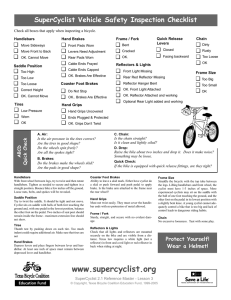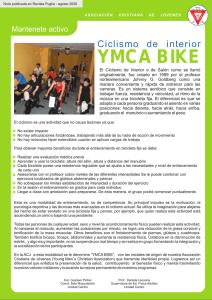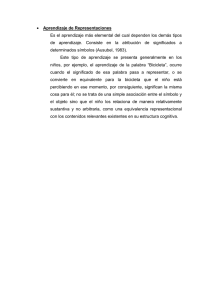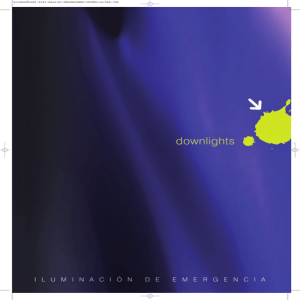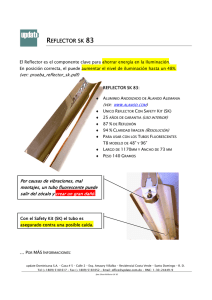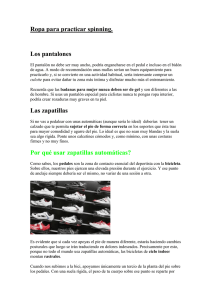2.1 Master Pages.qxd
Anuncio
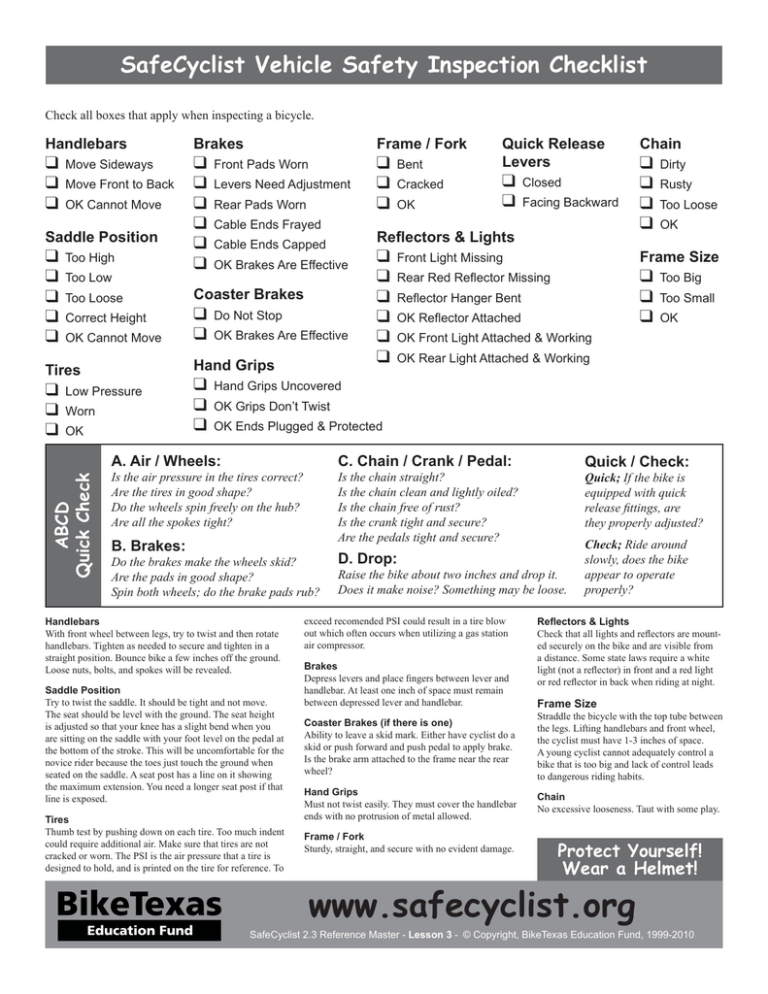
SafeCyclist Vehicle Safety Inspection Checklist Check all boxes that apply when inspecting a bicycle. Handlebars Brakes Frame / Fork Quick Release Levers Chain Move Sideways Front Pads Worn Bent Move Front to Back Levers Need Adjustment Cracked Closed Rusty OK Cannot Move Rear Pads Worn OK Facing Backward Too Loose Saddle Position Too High Cable Ends Frayed OK Reflectors & Lights Cable Ends Capped OK Brakes Are Effective Too Low Dirty Frame Size Front Light Missing Rear Red Reflector Missing Too Big Coaster Brakes Reflector Hanger Bent Too Small Correct Height Do Not Stop OK Reflector Attached OK OK Cannot Move OK Brakes Are Effective OK Front Light Attached & Working Too Loose OK Rear Light Attached & Working Hand Grips Tires Hand Grips Uncovered Worn OK Grips Don’t Twist OK OK Ends Plugged & Protected ABCD Quick Check Low Pressure A. Air / Wheels: C. Chain / Crank / Pedal: Quick / Check: Is the air pressure in the tires correct? Are the tires in good shape? Do the wheels spin freely on the hub? Are all the spokes tight? Is the chain straight? Is the chain clean and lightly oiled? Is the chain free of rust? Is the crank tight and secure? Are the pedals tight and secure? Quick; If the bike is equipped with quick release fittings, are they properly adjusted? B. Brakes: Do the brakes make the wheels skid? Are the pads in good shape? Spin both wheels; do the brake pads rub? Handlebars With front wheel between legs, try to twist and then rotate handlebars. Tighten as needed to secure and tighten in a straight position. Bounce bike a few inches off the ground. Loose nuts, bolts, and spokes will be revealed. Saddle Position Try to twist the saddle. It should be tight and not move. The seat should be level with the ground. The seat height is adjusted so that your knee has a slight bend when you are sitting on the saddle with your foot level on the pedal at the bottom of the stroke. This will be uncomfortable for the novice rider because the toes just touch the ground when seated on the saddle. A seat post has a line on it showing the maximum extension. You need a longer seat post if that line is exposed. Tires Thumb test by pushing down on each tire. Too much indent could require additional air. Make sure that tires are not cracked or worn. The PSI is the air pressure that a tire is designed to hold, and is printed on the tire for reference. To Education Fund D. Drop: Raise the bike about two inches and drop it. Does it make noise? Something may be loose. exceed recomended PSI could result in a tire blow out which often occurs when utilizing a gas station air compressor. Brakes Depress levers and place fingers between lever and handlebar. At least one inch of space must remain between depressed lever and handlebar. Check; Ride around slowly, does the bike appear to operate properly? Reflectors & Lights Check that all lights and reflectors are mounted securely on the bike and are visible from a distance. Some state laws require a white light (not a reflector) in front and a red light or red reflector in back when riding at night. Frame Size Coaster Brakes (if there is one) Ability to leave a skid mark. Either have cyclist do a skid or push forward and push pedal to apply brake. Is the brake arm attached to the frame near the rear wheel? Straddle the bicycle with the top tube between the legs. Lifting handlebars and front wheel, the cyclist must have 1-3 inches of space. A young cyclist cannot adequately control a bike that is too big and lack of control leads to dangerous riding habits. Hand Grips Must not twist easily. They must cover the handlebar ends with no protrusion of metal allowed. Chain No excessive looseness. Taut with some play. Frame / Fork Sturdy, straight, and secure with no evident damage. Protect Yourself! Wear a Helmet! www.safecyclist.org SafeCyclist 2.3 Reference Master - Lesson 3 - © Copyright, BikeTexas Education Fund, 1999-2010 Lista SafeCyclist de Revisión de Seguridad de Bicicleta Marca todas las cajas que se usan al revisar una bicicleta. Manubrio Frenos de Mano Cuadro / Tijera Cadena Se Mueve de Lado a Lado Zapatas del Frente Desgastadas Torcidos Sucia Se Mueve de Frente hacia Atrás Las palancas Necesitan Ajuste Rotos / Cuarteados Oxidada OK No se Puede Mover Zapatas Traseras Desgastadas OK Demasiado Floja Posición del Asiento Demasiado Alto Extremos del Cable Frayed Extremos del Cable Abiertos Tamaño del Cuadro Luz Delantera Perdida OK Los Frenos son Eficaces Demasiado Bajo Demasiado Flojo OK Reflectores y Luces Frenos de Pie (Contra Pedal) Reflector Rojo Trasero Perdido Demasiado Grande Base del Reflector Torcida Demasiado Pequeño OK Altura Correcta No Frenan OK Reflector Sujeto OK No se Puede mover Ok Los Frenos son Eficaces OK Luz Delantera Sujeta y Trabajando Llantas Luz Trasera Sujeta y Trabajando Puños / Grips Bloqueos Presión baja Grips Descubiertos Desgastadas Extremos Tapados y Protegidos Cerrados OK OK. Grips No se Tuercen Viendo hacia atrás ABCD Revisión Rápida A. Aire / Ruedas: C. Cadena / Multiplicación / Pedales: Revisión Rápida: ¿ Es correcta la presión en las llantas? ¿Las llantas están en buenas condiciones? ¿Las ruedas giran fácilmente? ¿Todos los rayos están apretados? ¿La cadena esta derecha? ¿Esta limpia y ligeramente lubricada? La cadena está libre de oxido? La palanca de multiplicación esta apretada y segura? Los pedales están apretados y seguros? Rápido; ¿Si la bicicleta está equipada con bloqueos, están apretados? B. Frenos: ¿Los frenos hacen que las ruedas derrapen? ¿Las zapatas están en buenas condiciones? Gira las dos ruedas; los frenos rosan en el rin? D. Déjala Caer: Levanta la bicicleta aproximadamente dos pulgadas y déjela caer sobre las llantas. ¿Hace ruido? Algo puede estar suelto. Manubrios Con la rueda delantera entre las piernas, intenta torcer y entonces gira el manubrio. Apriétalo como sea necesario para asegurar y apriétalo en posición recta. Deja caer la bicicleta sobre las llantas a unas pulgadas del suelo. Aparecerán las partes sueltas, tuercas, tornillos, y rayos. El PSI es la medida de presión de aire que una llanta está diseñada a aguantar, y está impresa en la llanta como referencia. El exceder la presión recomendada podría tener como resultado que la llanta explote, esto es común que ocurra cuando se utiliza un compresor de aire en una estación de gasolina. Posición del Asiento Intenta voltear el asiento. Debe estar firme y no tener movimiento. El asiento debe estar nivelado con el suelo. La altura del asiento debe estar ajustada, para que tu rodilla tenga un dobles ligero cuando estés sentado en el asiento, con tu pie nivelado en el pedal, al final del pedaleo. Esto será incómodo para el ciclista principiante porque los dedos del pie apenas tocan el suelo cuando estas sentado en el asiento. El poste de asiento tiene una línea que muestra la extensión máxima. Necesitarás un poste de asiento más largo si esa línea es expuesta. Frenos de Mano Oprime las palancas y pon los dedos entre la palanca y manubrio Por lo menos una pulgada de espacio debe permanecer entre palanca oprimida y el manubrio. Llantas Prueba la presión con el dedo pulgar empujando hacia abajo en cada llanta. Demasiado floja podría requerir aire adicional. Las llantas no deben estar cortadas o cuarteadas. Education Fund Chequeo; Maneja la bicicleta despacio, la bicicleta se ve que opera apropiadamente? Cuadro / Tijera Fuerte, recto, y seguro sin daño evidente. Reflectores y Luces Verifica que las luces y reflectores estén montados y asegurados en la bicicleta y que sean visibles a distancia. Las leyes de algunos estados requieren una luz blanca (no reflector) en el frente y una luz roja o reflector en la parte de atrás de la bicicleta para montar de noche. Frenos de Pie (Contra Pedal) Habilidad para dejar una marca de derrapon. Deja que un ciclista hacer (haga) un derrapon o empuja hacia adelante y empuja el pedal para frenar. ¿El brazo del freno esta sujeto al cuadro por la rueda trasera? Tamaño del Cuadro Monta la bicicleta con el tubo de encima entre las piernas. Levantando el manubrio y la rueda del frente, el ciclista debe tener de 1 - 3 pulgadas de espacio. Un joven ciclista no puede controlar una bicicleta adecuadamente cuando esta es demasiado grande, un mal control te lleva a una situación peligrosa. Grips / Puños No deben torcerse fácilmente. Deben cubrir los extremos del manubrio sin permitir que el metal sobresalga. Cadena Sin soltura excesiva. Tenso con algo de juego. www.safecyclist.org SafeCyclist 2.3 Referencia Maestra - Lección 3 - © Copyright, BikeTexas Education Fund, 1999-2010
